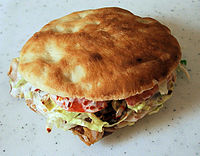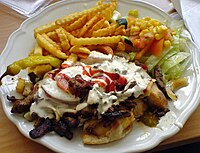| Revision as of 00:04, 23 November 2006 view sourceWolfgangFaber (talk | contribs)Extended confirmed users3,326 editsm Repairing link to disambiguation page (You can help!) Italian← Previous edit | Revision as of 04:39, 23 November 2006 view source Artaxiad (talk | contribs)16,771 edits →External linksNext edit → | ||
| Line 89: | Line 89: | ||
| ] | ] | ||
| ] | ] | ||
| ] | |||
| ] | ] | ||
| ] | ] | ||
Revision as of 04:39, 23 November 2006

Kebab (from Persian and Arabic کباب, kabāb) means "grilled (or broiled) meat" in Persian and several other related languages. Alternative spellings are: kebap, kabob, kibob, etc. Kebabs usually consist of lamb and beef, though particular styles of kebab have chicken or fish. Pork is never used for kebabs by Muslims because of the religious prohibition on the meat, but is sometimes used by non-Muslim sellers. Some sources have explained that kebab comes form two Persian words, namely Kam (meaning less) and Aab (meaning water), literally meaning cooked with less or no water. There are some exceptions however.
There are many varieties of kebab; the term has different meanings in different countries (see below). The generic term kebab usually refers to döner kebab in Europe, and to shish kebab in the United States, though its meaning varies.
Perhaps the earliest recipe is from the tenth-century Kitab al-Tabeekh كتاب الطبيخ (book of cookery) by Ibn Sayyar al-Warraq of Baghdad. His recipe for Kebab Khalis contains thin slices of lean meat, salted and grilled in an ungreased frying pan.
Döner kebab

Döner kebab, literally "rotating meat" in Turkish, is sliced lamb or chicken loaf which is slowly roasted on a vertical rotating spit. It is similar to gyros, shawarma, and Taco al pastor. Döner kebab is most popularly served in pita bread, as it is best known, with salad, but is also served in a dish with a salad and bread or French fries on the side, or used for Turkish pizzas called pide or "kebabpizza". Take-out döner kebab or shawarma restaurants are common in some parts of Europe. Döner Kebab is said to be the best-selling fast food in Germany and Poland, and comes close in the popularity stake-outs in France, Norway, Denmark, Sweden, Finland, and Australia. Take-out gyros are quite popular in the United States, where beef and lamb are typically used. Shawarma is available in ethnic neighborhoods, but döner kebab is mostly unknown outside of large cities like New York City.
Kebabs contain a variety of food groups: they have bread (cereals group), cabbage and lettuce (vegetables group), tomatoes (fruit group), creamy herb sauce (dairy group), oil (fat group), not to mention the döner meat (meat group); though one might consider the meat and vegetable groups misbalanced.
Shish kebab
Shish kebab (şiş kebap in Turkish) is a wooden or metal stick (a skewer in Turkish) with small cubes of any kind of meat, fowl, fish, fruit, or vegetable (usually a combination) which is roasted on a grill. The name literally means 'skewer of grilled meat' in Persian. Typical vegetables included are eggplant, tomato, bell pepper, onion and mushrooms. The similar Greek food is called Souvlaki or Kalamaki.
Some Kebab-variants

- Boryani Kebab
- Chapli Kabab - Pashtunistan - delicacy of Pashtunistan
- Kabab Halabi a kind of kebab served with a spicy tomato sauce, very common in Syria and Lebanon, named after the city of Halab.
- Kabab Torsh - (Gilan - Northern Iran) Also called (Tursh - e - Kabab) grilled beef marinated in a mixture of pomegranate juice, crushed walnuts, parsley, crushed garlic, and olive oil.
- Kofte Kebab or Shish köfte - minced lamb meatballs with herbs, often including parsley and mint, on a stick, grilled.
- Samak Kebab - grilled fish on a stick
- Seekh kabab - Afghanistan/Pakistan/India - marinated in spices and grilled on skewers
- Senjeh Kebab
- Shami kebab - Indian/Pakistani - it is claimed they orginated in Syria
- Shishleek - a term with various uses: in Iran it refers to grilled baby lamb chops (usually from the leg), typically marinated; in Palestine, to grilled pieces of lamb, and in Israel, to grilled turkey.
- Shish Tawook or Shish Taouk - yogurt marinated chicken grilled on a stick (şiş tavuk in Turkish)
- Souvlaki, Greek preparation; the meat is wrapped in grilled Greek-style pitta bread with tomatoes, onions and yoghurt.
- Tandoori Kebab - Indian/Pakistani - chunks or strips of meat marinated in spices and yogourt.
Persian
- Chenjeh Kabab - Grilled lamb prepared similar to shish kabab, without the vegetables
- Chelow kabab
- Jujeh Kabab - Grilled chicken
- Kabab Bareh - Grilled lamb, typically marinated in yogurt with parsley
- Kabab Barg - Grilled marinated sirloin.
- Kabab Koobideh - Ground beef or lamb (usually sirloin), often mixed with parsley and chopped onions
- Kabab loghmeh - Minced lamb meatballs first fried and the grilled over charcoal fire, eaten with chopped parsley, chopped onions, and somak. A summer outing favorite.
- Kabab Soltani - Combination of kabab koobideh and kabab barg
Turkish Kebabs
- Adana Kebab - Kebab meat with chili, associated with Adana region although very popular all over Turkey.
- Alanya kebab - Pieces of beef, bread and tomatoes, with a spicy sauce, invented in Alanya.
- Beyti Kebab - Minced lamb roasted with a special spice mix, and a touch of garlic, traced back to the famous kebab house Beyti in İstanbul and particularly popular in Turkey's larger cities.
- Cağ Kebab - Cubes of sliced lamb roasted first on a horizontal rotating spit and then on a skewer, a specialty of Erzurum region with recently rising popularity.
- İskender kebap - Döner kebab served with yoghurt, tomato sauce and butter, traced back to the famous kebab house İskender in Bursa.
- Aubergine Kebab (Patlıcan Kebab in Turkish) - Special kebab meat marinated in spices and served with aubergines, hot pide bread and a yoghurt sauce.
- Urfa Kebab - Similar to Adana Kebab, but not spicy.
- Tandır Kebab - Lamb pieces (sometimes a whole lamb) baked in a oven called tandır. Which requires a special way of cooking for hours. Served with bread and raw onions.
The dish called chelow kabab (rice with kabab) is one of the most common forms of serving kabab in Iran which combines a variety of Persian kababs with saffroned Basmati rice, lavash (a paper-thin bread), grilled tomato, raw onions, bell peppers, mushrooms and Somagh and often a side of salad shirazi, mast khiyar and doogh (nowadays carbonated). An old Iranian tradition is to break a raw egg yolk over the rice, along with plenty of butter, just before serving.
An Indian dish called Seekh Kebab is popular in many Indian restaurants. It is cooked in a tandoor, and is often served with chutneys or mint sauce. It is often included in Tandoori sampler platters, which contain a variety of Tandoor cooked dishes. A Seekh Kebab can also be served in a naan bread much like a Donor Kebeb traditionally is.
Shish Kebab in Other Languages
- Albanian: shishqebab
- American English: kabob (plural: kabobs)
- Armenian: khorovats/khorovadz
- Azeri: kabab
- Bosnian/Croatian/Serbian: šiš ćevap, ražnjić (plural: ražnjići)
- Finnish: kebab
- Slovenian: ražnjič (plural: ražnjiči)
- Macedonian: ражнич (ražnič), шиш ќебап (šiš kebap)
- Danish: kebab
- Georgian: მწვადი (mtsvadi).
- Hebrew: kabab, plural: kababim
- Italian: kebàb, plural: kebàb
- Norwegian: kebab (most often served chopped up in a pita bread, consumed with a plastic fork), babb (slang)
- Tagalog: barbicue, bar-b-q (this food is similar to the kebab)
- Romanian: kebab, plural: kebaburi
- Russian: шашлык, plural: шашлыки
- Spanish: Pincho(peen-cho), plural: Pinchos ;Brocheta, plural: Brochetas
- Ukrainian: шашлик, plural: шашлики
- Polish: kebab
Similar dishes
Anticuchos (Andean States), Brochette (French), Ćevapi (Balkans), Espetada (Portuguese), მწვადი mtsvadi (Georgia), kebakko (Finland), Satay (Southeast Asian), Shashlik (Russian), Souvlaki or Kalamaki (Greek), Yakitori (Japanese), Spiedies (New York State), Rablóhús (Hungarian)
External links
- Turkish Kebabs, at TurkishCook.com
- The Chili Source, has images of several types of kebabs
- Kebab Recipes Pakistani Kebab Recipes @ KhanaPakana.Com